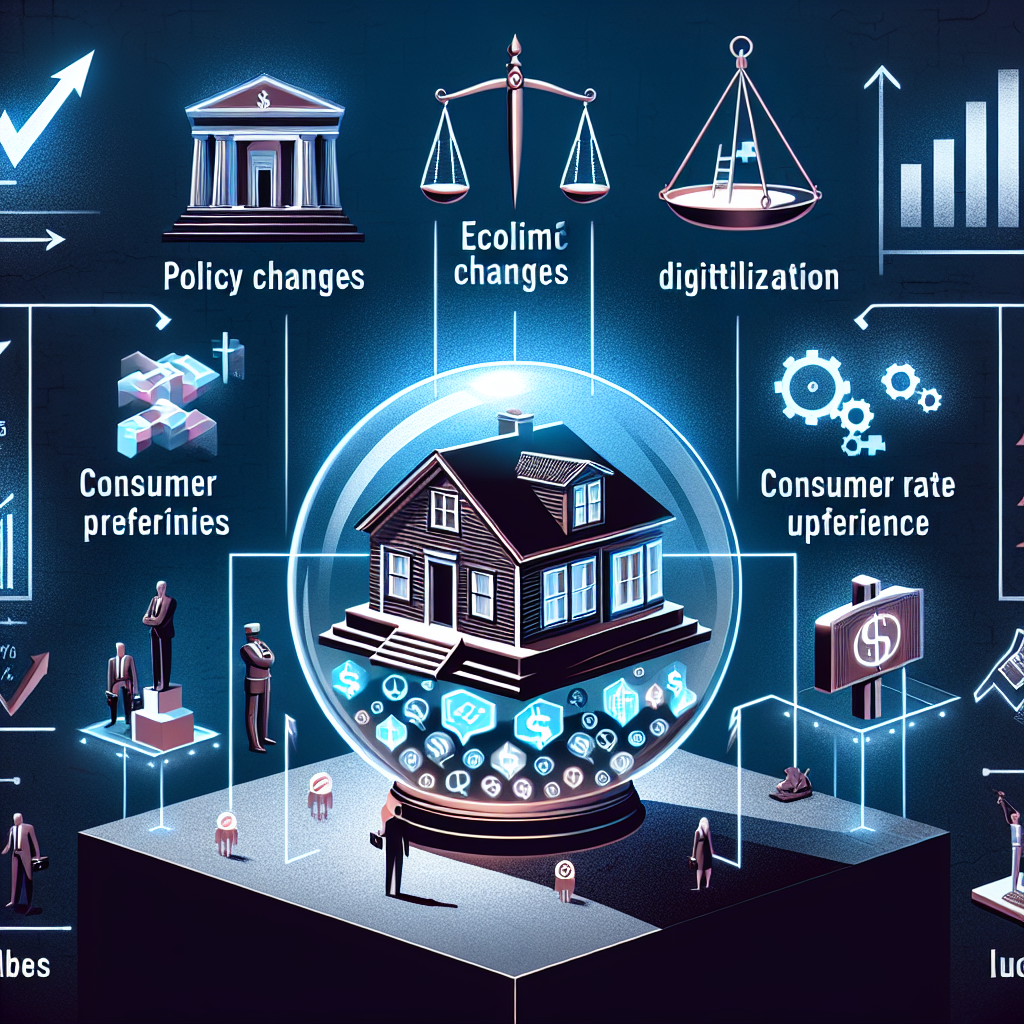-
 The Current Landscape of Mortgage Origination: Trends and Challenges
The Current Landscape of Mortgage Origination: Trends and Challenges Explore current trends and challenges in the U.S. mortgage origination market, including interest rate fluctuations, digital mortgage solutions, and compliance needs.
Explore current trends and challenges in the U.S. mortgage origination market, including interest rate fluctuations, digital mortgage solutions, and compliance needs.
Five Critical Factors to Consider When Developing a Digital Mortgage Strategy
- Friday, 25 January 2019
- Lending

By Mikhail Cook
We are now a few years removed from the Super Bowl commercial that shook the slow to change mortgage industry to its core.
But, frankly, it was needed.
Having worked in mortgage technology for the past 17 years, it has always been amazing to me how slow the industry has been to adopt technologies that are table stakes, or minimum requirements, in the consumer space.
That said, there has been a noticeable increase in innovation over the past few years, which has enabled some firms to gain market share; others have developed a plan, but did not have the ability to execute it; and still others, unfortunately, are losing the battle.
With so much investment being poured into the segment from non-mortgage industry veterans, it is not hard to ascertain why we still face rising costs to originate, despite this being the most digital the mortgage industry has ever been.
[caption id="attachment_9425" align="alignright" width="214"] Mikhail Cook[/caption]
Mikhail Cook[/caption]
At a surface level, it is nice to have an e1003 and having a nice user interface provides a “wow” factor. However, without an end-to-end strategy, organizations are solving just one piece of a very large puzzle.
In this article, I will discuss five critical factors to consider when developing and executing an end-to-end digital mortgage strategy. They are meant to help guide and ensure your organization can implement technology to increase market share, rather than losing it to competitors.
- What are the key objectives your organization is looking to accomplish?
Understanding organizational objectives is something that is critical when developing a digital-mortgage strategy. For several years, top-200 lenders and financial technology firms have been reacting to the competition. Sure, there will always be a first mover. However, if what you are planning to do over the next one to three years is not in lockstep with a broader set of enterprise objectives, then the results will be disappointing.
Among the key objectives that could be selected are the following:
- Increased market share in a bid to leapfrog the competition.
- Improved customer satisfaction, such as more transparency into the loan-manufacturing process, improved customer retention capabilities, and increased self-service capabilities.
- Enhanced user experience through omnichannel engagement capabilities or more intuitive user interfaces.
- Reduced pain points, such as time to market constraints for system enhancements, costs to implement change, cycle times for exception management in sales and fulfillment.
- Establishing lending practices that are more compliant
- Launching true end-to-end digital loan origination and servicing capabilities.
- How do vendors’ capabilities and product roadmap align with your key objectives?
With vendors, it is critical to have a thorough understanding of whom you will be interfacing with and what they are trying to accomplish as an organization. Additionally, when they are planning to get there, why they are going there and how they intend to get there.
There is one other key item: How capable is the vendor of executing on that plan. The importance of a synergistic vendor partner can’t be emphasized enough. Look for one that can help you innovate at a pace not possible for companies that work on their own. But, remember, an unaligned partner can leave a client crippled.
- What are the technical capabilities of your organization?
When looking to execute on determined objectives, it is important for the organization to be brutally honest with itself, and determine the risks associated with acquiring solutions that will support the next set of key objectives. Firms have the option to buy or build technology; or they can buy and extend the solutions they license.
Which choice is right is something that each organization will need to assess. Some key factors to weigh are your organization’s current internal domain expertise. Are these capabilities a core competency? How critical are they to the organization now, in the foreseeable future, and are they deemed worthy of continued investment?
- How can the work be segmented into a journey of manageable milestones rather than an endpoint or big block of work?
Unfortunately, with technology, you do not ever arrive; it’s never complete.
But that is an exciting aspect to it as well.
It is important for the journey to be measurable and to move at a cadence that is sustainable. Also, it is essential for key constituents to have visibility into the process and progress of initiatives.
Last, it is key to have a true commitment to continuous process improvement. Learning and adjusting will give your organization an opportunity to continue to gain velocity over time, while also improving the quality of its processes.
- Know your organization's risk appetite
It is one thing to have lofty goals and aspirations, but it is another to stretch the organization beyond its risk appetite. Managing this balancing act, throughout the digital journey, is critical. In addition, it is important to have key objectives understood by everyone within the organization and by your vendor partners.
That transparency serves to help reduce ongoing risks in a dramatic fashion. Also, by committing to continuous process improvement, it’s possible to course correct along the journey.
In a very competitive industry, in which basis points matter and with so many new entrants into the market, it is impossible for there not to be some level of consolidation. Some will view that as a bad thing, while others will view it as an opportunity.
By using these five factors, it’s possible to reduce unplanned technology debt, remain nimble, improve customer satisfaction and execute on your critical strategies in 2019 and beyond.
About the Author: Mikhail Cook is senior vice president at EXOS Technologies, a provider of digital technology services to the mortgage industry and a ServiceLink company. If you have a question, or would like more information, email him at This email address is being protected from spambots. You need JavaScript enabled to view it..
Read more...Black Knight Upgrades Digital-Closing Solution
- Wednesday, 16 January 2019
- Lending

Black Knight has enhanced the Expedite Close digital closing solution with advanced intelligence and data recognition capabilities. The platform has been able to support wet-ink, digital or hybrid mortgage closings, the upgrades will help determine the best way to close a loan based upon a lender's preferences and business rules, as well as jurisdiction-specific requirements.
"Right now, mortgage closing requirements are inconsistent and inefficient across the country, and even from lender to lender, or agent to agent," said Mike Brown, general manager of Black Knight's Lending Solutions division. "Expedite Close was designed to meet the challenges of today's closings, while delivering maximum benefit to our clients and their customers, and making the process, and implementation, as simple as possible."
Expedite Close can support fully digital closings, including eSign, eNotary and eClose components. For closings that are not fully digital, it automatically identifies and executes whatever combination of wet-ink and digital closing works best for the lender or the property jurisdiction, saving significant cost and time. Users cans adopt the features that meet their needs, or deploy complete digital closings, according to their timelines.
Also, advanced document-recognition capabilities enable static PDFs of closing documents to become searchable, eSignable and data-centric, allowing Expedite Close to streamline the post-closing process. The objective is to achieve increased speed, improve efficiency in the closing process, and support consistent origination process.
Expedite Close enhances the consumer experience by providing a more streamlined closing with the ability to review all necessary documents before the actual closing and eSign-appropriate documents. Lenders and settlement agents not only benefit from improved borrower satisfaction, but also from reduced risk and enhanced efficiencies without having to significantly alter their current processes.
Read more...30-Year Industry Vet, Successful Producer Joins loanDepot
- Friday, 04 January 2019
- Lending

John Bianchi, a 30-year veteran of the mortgage business, has been named executive vice president for national sales at loanDepot. He will work with the executive team to cultivate and enhance market presence, develop differentiated products and services and create market penetration strategies designed to fuel individual producer as well as channel and company growth.
In addition to his management acumen, Bianchi is also a top-personal performer, having formerly been recognized as one of the top five mortgage originators in the country. “Coming from a background of personal production like I do, means that I know how important the right products, the right technology and the right operational processes are to loan officers and customers alike,” said Bianchi.
[caption id="attachment_8862" align="alignright" width="222"] Bianchi brings a track record as a sales executive and top originator.[/caption]
Bianchi brings a track record as a sales executive and top originator.[/caption]
Prior to joining loanDepot, Bianchi served as executive vice president of national retail lending for Caliber Home Loans, and he has held sales leadership positions with Bank of America and Countrywide Home Loans.
"Our commitment to professional loan officers and the retail channel has never wavered," said Anthony Hsieh, founder and chief executive officer of loanDepot. "We believe in distributed retail, and we want to grow this segment of our business. John's hire reconfirms this commitment and positions us to further invest in the tools, products and technology that today's retail loan officer needs to win.”
Bianchi will report to Dan Hanson, chief production officer, and will work with executive leaders and teams across companies, channels and verticals to cultivate and enhance market presence, develop differentiated products and services and create market penetration strategies designed for growth. loanDepot's team of divisional executive managers will report to Bianchi, giving him oversight responsibility for more than 1,000 employees and 100,000 customers.
“I know how committed loanDepot is to retail and how committed it is to increasing volume and velocity, which means the company is very well positioned to take advantage of the changes that are occurring in our industry and in consumer behavior, said Bianchi.
Read more...
CoreLogic to Enhance AMC; Will Exit LOS, Default Businesses
- Friday, 21 December 2018
- Lending

CoreLogic plans to enhance its appraisal management company services and will exit the loan origination software business and default management related services over the next couple of years in a bid to increase profit margins and enhance long-term organic growth trends.
“The actions we are announcing today should further position the company to achieve its 30 percent margin target and enhanced organic growth rates in 2020,” said Frank Martell, president and chief executive officer of CoreLogic.
[caption id="attachment_8671" align="alignleft" width="264"] Frank Martell[/caption]
Frank Martell[/caption]
Loan origination software and default management related services generated around $40 million in revenue during the first nine months of 2018. But the company will focus on business units that are scalable, and in which CoreLogic has a leadership position in the market.
During 2019, CoreLogic plans to accelerate its multi-year program designed to transform its AMC operations through the greater use of data-driven analytics, automation of workflows and enhanced use of dedicated staff appraisers. This acceleration is expected to improve client satisfaction, reduce appraiser turn times, enhance quality and increase productivity. The decision to exit these businesses is expected to result in lower revenue in 2019, but it will enhance overall profit margins and improve underlying organic growth trends in 2020 and beyond.
AMC revenues estimated to be impacted from this acceleration were approximately $65 million during the first nine months of 2018. According to the company, the long-term revenue growth rate trend and contribute to the achievement of 30 percent adjusted EBITDA margins in 2020. Corelogic might incur cash and non-cash charges associated with these business decisions.
Read more...





